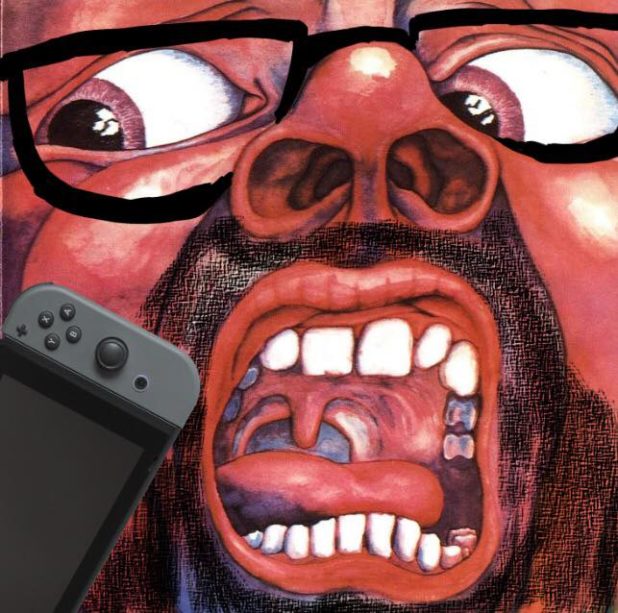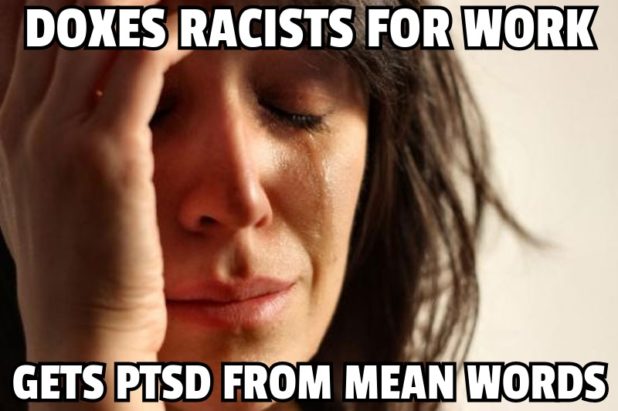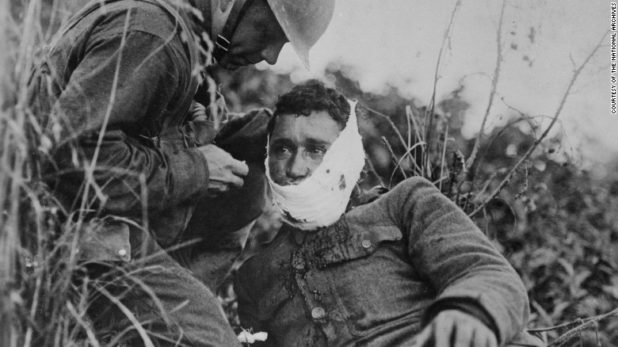Adrian Sol
Daily Stormer
May 16, 2018
I’m sure it’s real – in your mind.
Wow, we got a real scoop here guys.
It turns out that when these filthy journalists investigate White nationalists with the purpose of destroying their lives forever, the true victims aren’t the people getting doxed and defamed. The true victims are actually the journalists themselves, because – and get this – they’re getting some totally-not-made-up thing called “digital PTSD.”
You see, mere exposure to racism or intolerance or whatever is shattering their fragile minds, which will presumably require years of counselling – at their employer’s expense, of course.
So if you ever feel down, just remind yourself that your very existence is enough to do permanent psychological damage to these faggots.
Journalists covering the alt-right are experiencing the debilitating effects of online harassment and violent imagery.
The 21st century bugman is paid to dox alt-righters, but all he really wants is to go home and play with his Switch.
Last year, the most dangerous place to be a journalist in America was at a protest. According to a March report released by U.S. Press Freedom Tracker, protests were home to 29 arrests and 31 known physical attacks on journalists in 2017 alone. Other attacks on press freedom included having equipment seized and searched by law enforcement, or being denied access to traditionally open government events.
Yeah, I’m sure covering BLM and antifa protests is pretty dangerous. These people are nuts.
I’ve never heard of right-wingers attacking journalists, though. I guess it’s still our fault somehow these people are getting attacked.
Research reported by the Dart Center has shown that between 80 and 100 percent of journalists experience work-related trauma at some point in their career, and between 4 and 59 percent suffer from post-traumatic stress disorder. According to the study, journalists exposed to “events involving death, violence, and human suffering” while covering war or natural disasters are especially at risk of trauma, though not all journalists who witness tragic events will experience PTSD.
These faggots have literally the easiest, least stressful job in the world – by a long shot.
“Oh, no, I have one week to write an article, such stress, I’m going to kill myself.”
If they’re getting PTSD writing shitty posts at a desk in an air-conditioned downtown office, I wonder how they’d handle being police officers in a Black neighborhood? Or, you know, fighting on a battlefield, like people who have real PTSD have?
Anyway, here follows a bunch of accounts from whining journalists describing how contact with White nationalism obliterated their psyches.
I was diagnosed with PTSD two days after I got back from Virginia. In the weeks and months that followed, I experienced flashbacks, nightmares, insomnia, dissociation, chronic body pain, and severe depression and anxiety — symptoms that interfered with my work reporting on fascists, but that were triggered by it, too. Every time I looked up photos of protesters clashing with neo-Nazis in Charlottesville, or videos of the car attack, it was like I was back on that street corner. Even while reporting this story, I’ve had flashbacks to it, though they’re more manageable now.
In a 2015 study by the British Psychological Society, 22 percent of individuals — though not journalists specifically — who repeatedly looked at violent videos or photos on social media scored high on clinical measures of PTSD. Not surprisingly, many of the journalists I spoke to for this story who have covered far-right extremism said they found it hard to return to normal life after covering these groups and digitally monitoring their activity.
Man, good thing they renamed “shell-shock” to PTSD, otherwise all these women and pansies would feel pretty embarrassed claiming to have the same syndrome as soldiers who saw their friends get blown to bits over and over again.
Hey, don’t complain. It could be worse. You could be a journalist covering the Alt-Right.
Over the course of the day, Al-Sibai said she followed the violent events on Facebook and Twitter, compulsively checking for updates “pretty much every 20 minutes.” Over the next week, she was doing what she described as “round the clock coverage” of the fallout. Al-Sibai said that being exposed to the neo-Nazis’ hateful speech took a toll, especially as an Arab-American woman with a Muslim upbringing. “These White Supremacists are so over the top about Jews and Muslims,” she said.
In the weeks that followed, she reported symptoms of post-traumatic stress, such as dissociation, flashbacks to prior trauma, and recurring nightmares. “When I was on the clock, I don’t even think I could identify [the triggers],” she recalled. “It was very much a blur. I’m missing some of that time.”
Poor dear.
“You dig through [Discord logs] for hours and hours and spend a lot of time seeing what they say, and watching them formulate plans, and the weird, sick jokes they make online,” said freelance journalist Elizabeth King. “Seeing them in real life or knowing you will because you cover them, it’s super jarring.”
While reading up on the alt-right for an upcoming book about fascism and free speech, [Peter] Moskowitz remembered coming across some particularly violent and triggering conversations online. “I was trying to do research on how the alt-right was trying to frame Charlottesville and was seeing pictures of Heather Heyer’s body and people making fun of her weight,” Moskowitz said. “To see what was so traumatic for me be turned into a joke and a fat-shaming session was like ‘Wow, really no one cares.’”
Yeah, your stupid narrative would have completely collapsed if we’d been allowed to inform the public that the landwhale died of a heart attack because of her obscene weight, and not because of any contact with that Dodge Challenger of fate.
Also, if people had simply been allowed to know how fat she is, there would have been little sympathy – and you all knew it. Otherwise, why would you have used an old picture, instead of the most recent ones?
Any normal American, upon seeing this, would go like “dat fat hoe wasn’t long for this world, anyway.” Also, what kind of White person smokes Newports? Wew.
Sadly, the culture of the industry hasn’t caught up with the need for trauma awareness. As journalist Mac McClelland told the Huffington Post, talking to her colleagues about her own PTSD would leave her feeling like others thought she was “weak and vulnerable.”
To minimize harm to reporters, editors and journalists alike need to acknowledge the risks that come with reporting specific stories, and create more space for discussing them.
In other words, they want attention, sympathy and probably money. All for sitting their asses on a desk all day writing low-quality, wildly inaccurate posts on their mainstream media blogs.
The front line forces of the enemy are so fragile that mere contact with us and our culture is enough to completely blow their mind. This is the level of human material we’re dealing with here.







